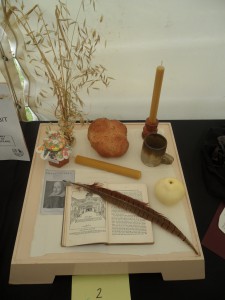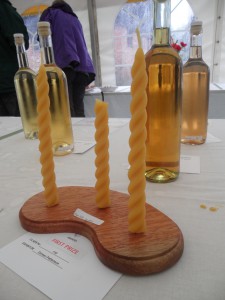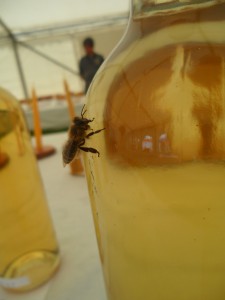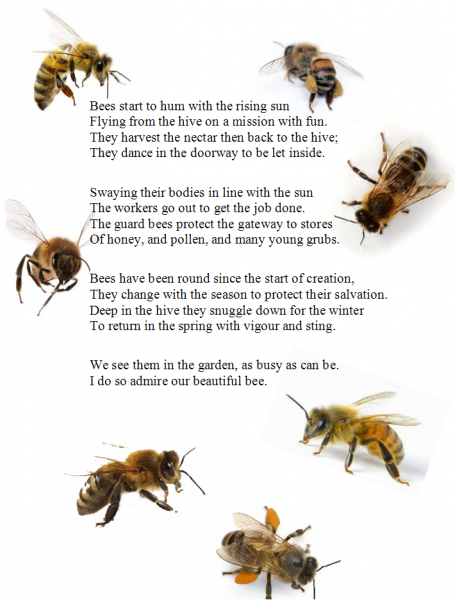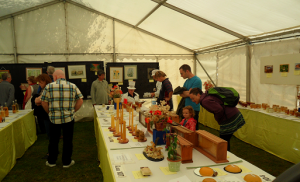When people hear we’re beekeepers, one of the questions that sometimes comes up is “why keep bees, apart from the honey?” Well, there are lots of things we get from bees aside from honey. And this fact is celebrated each year with a class at the Harrow-in-Leaf show, the “products of the hive” display. This is judged on artistic presentation of at least six products from the beehive; nothing’s tasted, nothing’s measured, it’s just about how the display looks. Some competitors concentrate on pure visual effect, and the results can be stunning; but each year we try and come up with a theme, something that tells a story. Last year we did Winnie-the-Pooh’s picnic; this year it seemed appropriate to theme it around the centenary of the start of the Great War.
We needed at least six different products, and we thought of 4 or 5 pretty easily; thereafter it gets a little harder, but here are the ten that we came up with that we could represent in the display:
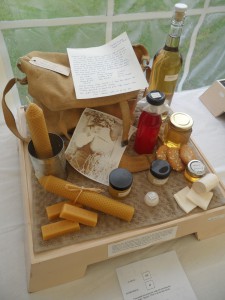 Honey dressings (honey has healing and antiseptic qualities that are sometimes used in trauma cases)
Honey dressings (honey has healing and antiseptic qualities that are sometimes used in trauma cases)- Foot cream (great for trench-foot)
- Lip-balm
- Wax polish (really good for wood, but can also be used on leather)
- Honey-and-oat cookies
- Jar of honey
- Wax candle
- Block of wax
- Berry-and-honey vinegar (great for sore throats – when diluted!)
- Mead
So these were our items, and they were to be presented with a WWI theme, but how to link them together? We came up with the idea of a “package from home” and found a rough canvas bag that looked vaguely military, but the story needed strengthening so we decided to write a “letter from home”. We found a photograph of a beekeeper collecting a swarm into a skep from 1914, so that was to be worked into the story too. I wanted the letter to be believable and refer to real events, so started a little Googling, and very quickly came across the story of Private John Parr. We worked some details into the letter and combined it with the above list of products. As we researched more, we found just one personal tragedy out of hundreds of thousands, made all the more poignant because John Parr’s home was less than 10 miles from Harrow, and we were writing the letter on the 100th anniversary of his death.
John Henry Parr, from North Finchley, is believed to be the first British soldier killed by enemy action in the Great War. He was shot, thought to have been on a reconnaissance mission on 21st August 1914, when he was aged just 17, the youngest of eleven siblings. His body was never returned to England, and it was after the war that his mother, Alice, was notified of his death. They continued to write to him until that time.
The story was so powerful we felt it needed telling, so as a postscript to the display added a printed note, the paragraph above, to the front of the display. There was no evidence that any of John’s family were beekeepers, and we did put this disclaimer on the display. We hope that visitors will have been both touched by the story of John and his family, and learn a little more about the uses of honey and other products of the hive. Because in our 10 products we’ve only scratched the surface; as well as honey, the rarer substances of propolis, royal jelly and bee venom have remarkable properties … maybe the subject of a future blog.
P.S. The judges must have been impressed by what they saw, as we were thrilled to share first prize and the cup!
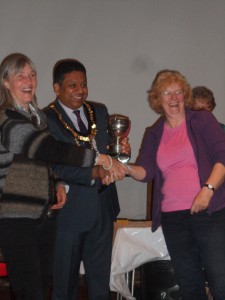
Receiving the cup
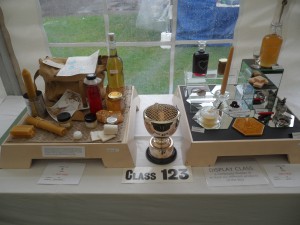
The winning entries
North Finchley
21st August 1914
Dearest John,
We pray this small parcel reaches you safe and finds you in good health. Your father and I, and all your brothers and sisters, miss you dreadfully but are so proud of you. It must seem a million miles away from North Middlesex. Your old boss the butcher took this photograph of your father collecting that swarm earlier this year, before the war started. We’ve been busy and all the following are made with produce from the hive:
| Lip Balm |
Honey dressings |
Candles |
| Foot cream |
Leather polish |
Honey |
| Honey & Oat biscuits |
Wax blocks |
Berry vinegar |
and of course some mead ~ I do hope the officers let you share this with your chums.
Looking forward so much to your safe return once this awful thing is over.
Your Mother, with all of my love.

